YAMAHA WR 250F 2015 Owner's Manual
Manufacturer: YAMAHA, Model Year: 2015, Model line: WR 250F, Model: YAMAHA WR 250F 2015Pages: 430, PDF Size: 14.14 MB
Page 21 of 430
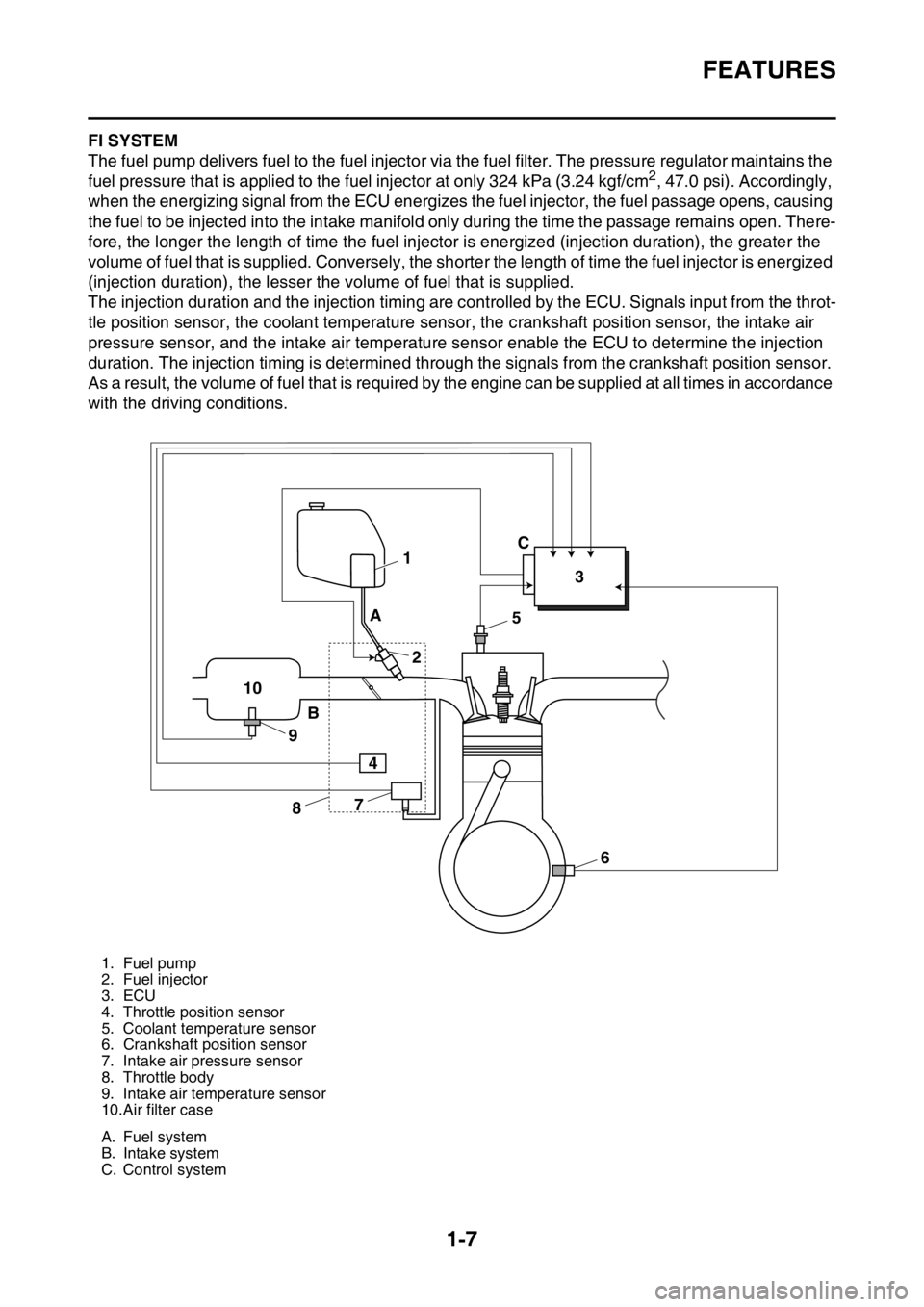
FEATURES
1-7
EAS2GB2015FI SYSTEM
The fuel pump delivers fuel to the fuel injector via the fuel filter. The pressure regulator maintains the
fuel pressure that is applied to the fuel injector at only 324 kPa (3.24 kgf/cm
2, 47.0 psi). Accordingly,
when the energizing signal from the ECU energizes the fuel injector, the fuel passage opens, causing
the fuel to be injected into the intake manifold only during the time the passage remains open. There-
fore, the longer the length of time the fuel injector is energized (injection duration), the greater the
volume of fuel that is supplied. Conversely, the shorter the length of time the fuel injector is energized
(injection duration), the lesser the volume of fuel that is supplied.
The injection duration and the injection timing are controlled by the ECU. Signals input from the throt-
tle position sensor, the coolant temperature sensor, the crankshaft position sensor, the intake air
pressure sensor, and the intake air temperature sensor enable the ECU to determine the injection
duration. The injection timing is determined through the signals from the crankshaft position sensor.
As a result, the volume of fuel that is required by the engine can be supplied at all times in accordance
with the driving conditions.
1. Fuel pump
2. Fuel injector
3. ECU
4. Throttle position sensor
5. Coolant temperature sensor
6. Crankshaft position sensor
7. Intake air pressure sensor
8. Throttle body
9. Intake air temperature sensor
10.Air filter case
A. Fuel system
B. Intake system
C. Control system
1
23
5
6 7
8 9 10A
BC
4
Page 22 of 430
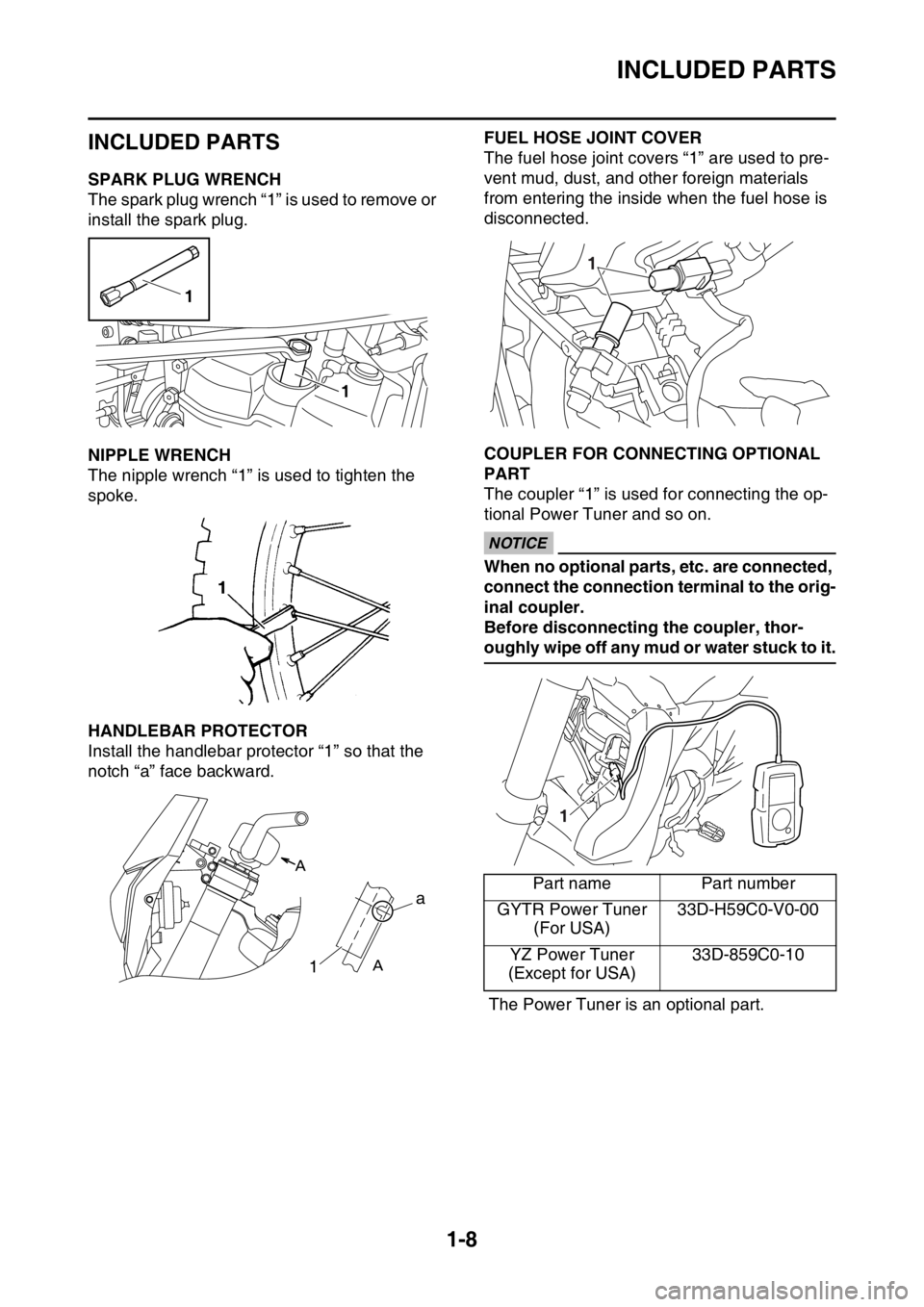
INCLUDED PARTS
1-8
EAS2GB2016
INCLUDED PARTS
EAS2GB2017SPARK PLUG WRENCH
The spark plug wrench “1” is used to remove or
install the spark plug.
EAS2GB2018NIPPLE WRENCH
The nipple wrench “1” is used to tighten the
spoke.
EAS2GB2019HANDLEBAR PROTECTOR
Install the handlebar protector “1” so that the
notch “a” face backward.
EAS2GB2020
FUEL HOSE JOINT COVER
The fuel hose joint covers “1” are used to pre-
vent mud, dust, and other foreign materials
from entering the inside when the fuel hose is
disconnected.
EAS2GB2021COUPLER FOR CONNECTING OPTIONAL
PART
The coupler “1” is used for connecting the op-
tional Power Tuner and so on.
ECA
NOTICE
When no optional parts, etc. are connected,
connect the connection terminal to the orig-
inal coupler.
Before disconnecting the coupler, thor-
oughly wipe off any mud or water stuck to it.
The Power Tuner is an optional part.
1
1
1
aPart name Part number
GYTR Power Tuner
(For USA)33D-H59C0-V0-00
YZ Power Tuner
(Except for USA)33D-859C0-10
1
1
Page 23 of 430
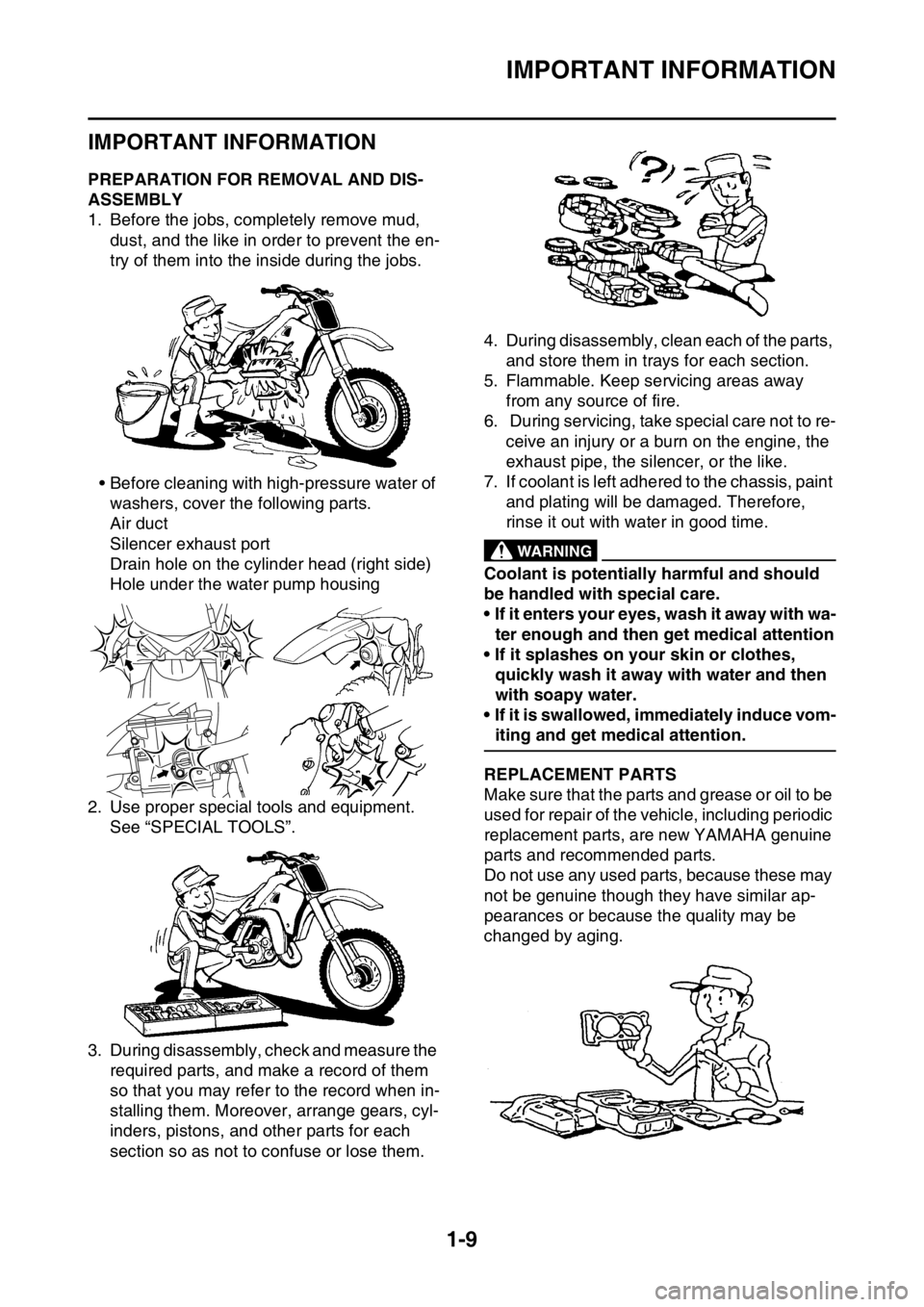
IMPORTANT INFORMATION
1-9
EAS20180
IMPORTANT INFORMATION
EAS2GB2022PREPARATION FOR REMOVAL AND DIS-
ASSEMBLY
1. Before the jobs, completely remove mud,
dust, and the like in order to prevent the en-
try of them into the inside during the jobs.
• Before cleaning with high-pressure water of
washers, cover the following parts.
Air duct
Silencer exhaust port
Drain hole on the cylinder head (right side)
Hole under the water pump housing
2. Use proper special tools and equipment.
See “SPECIAL TOOLS”.
3. During disassembly, check and measure the
required parts, and make a record of them
so that you may refer to the record when in-
stalling them. Moreover, arrange gears, cyl-
inders, pistons, and other parts for each
section so as not to confuse or lose them.4. During disassembly, clean each of the parts,
and store them in trays for each section.
5. Flammable. Keep servicing areas away
from any source of fire.
6. During servicing, take special care not to re-
ceive an injury or a burn on the engine, the
exhaust pipe, the silencer, or the like.
7. If coolant is left adhered to the chassis, paint
and plating will be damaged. Therefore,
rinse it out with water in good time.
EWA
WARNING
Coolant is potentially harmful and should
be handled with special care.
• If it enters your eyes, wash it away with wa-
ter enough and then get medical attention
• If it splashes on your skin or clothes,
quickly wash it away with water and then
with soapy water.
• If it is swallowed, immediately induce vom-
iting and get medical attention.
EAS2GB2023REPLACEMENT PARTS
Make sure that the parts and grease or oil to be
used for repair of the vehicle, including periodic
replacement parts, are new YAMAHA genuine
parts and recommended parts.
Do not use any used parts, because these may
not be genuine though they have similar ap-
pearances or because the quality may be
changed by aging.
Page 24 of 430
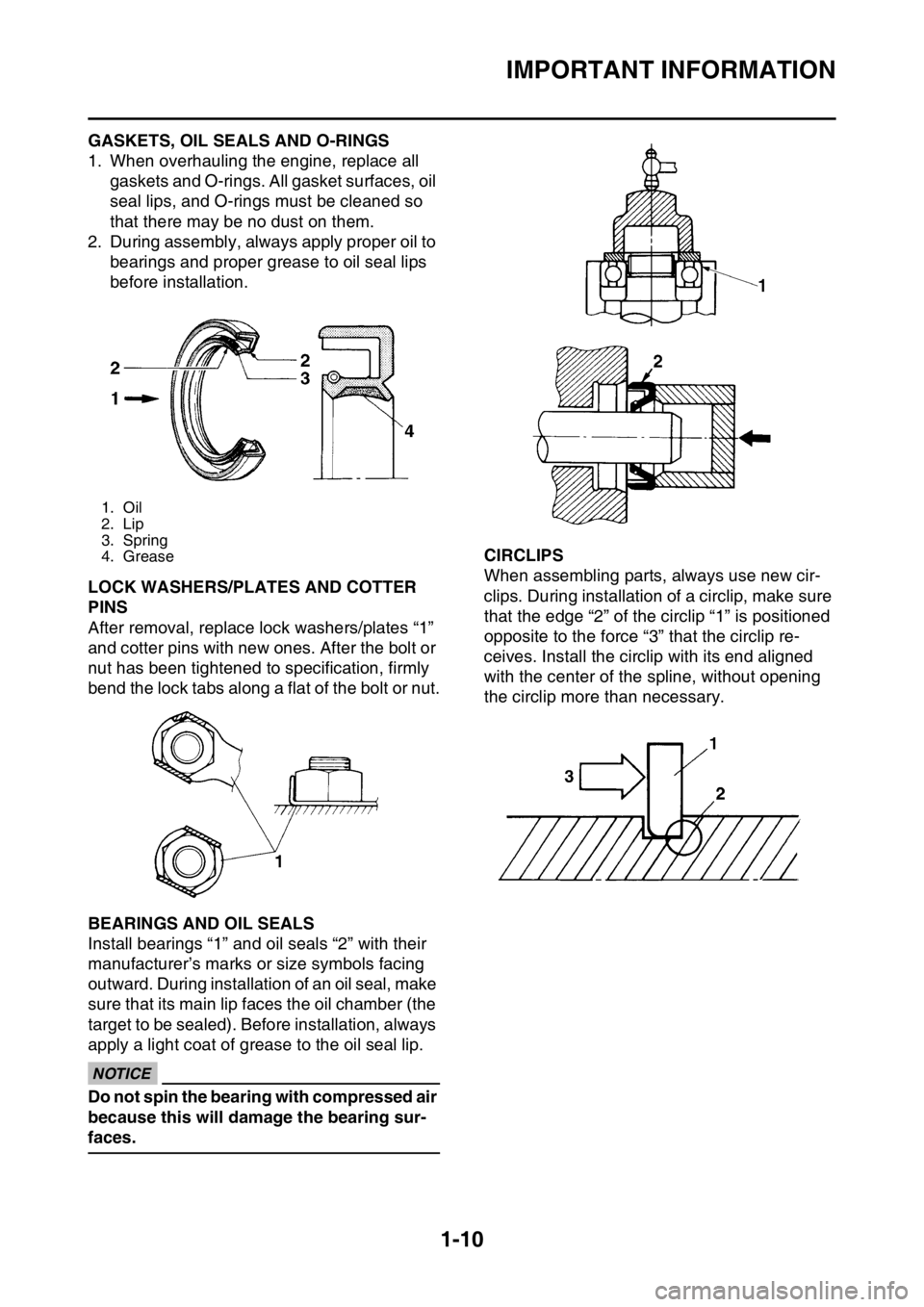
IMPORTANT INFORMATION
1-10
EAS2GB2024GASKETS, OIL SEALS AND O-RINGS
1. When overhauling the engine, replace all
gaskets and O-rings. All gasket surfaces, oil
seal lips, and O-rings must be cleaned so
that there may be no dust on them.
2. During assembly, always apply proper oil to
bearings and proper grease to oil seal lips
before installation.
EAS2GB2025LOCK WASHERS/PLATES AND COTTER
PINS
After removal, replace lock washers/plates “1”
and cotter pins with new ones. After the bolt or
nut has been tightened to specification, firmly
bend the lock tabs along a flat of the bolt or nut.
EAS2GB2026BEARINGS AND OIL SEALS
Install bearings “1” and oil seals “2” with their
manufacturer’s marks or size symbols facing
outward. During installation of an oil seal, make
sure that its main lip faces the oil chamber (the
target to be sealed). Before installation, always
apply a light coat of grease to the oil seal lip.
ECA
NOTICE
Do not spin the bearing with compressed air
because this will damage the bearing sur-
faces.
EAS2GB2027CIRCLIPS
When assembling parts, always use new cir-
clips. During installation of a circlip, make sure
that the edge “2” of the circlip “1” is positioned
opposite to the force “3” that the circlip re-
ceives. Install the circlip with its end aligned
with the center of the spline, without opening
the circlip more than necessary.
1. Oil
2. Lip
3. Spring
4. Grease
Page 25 of 430
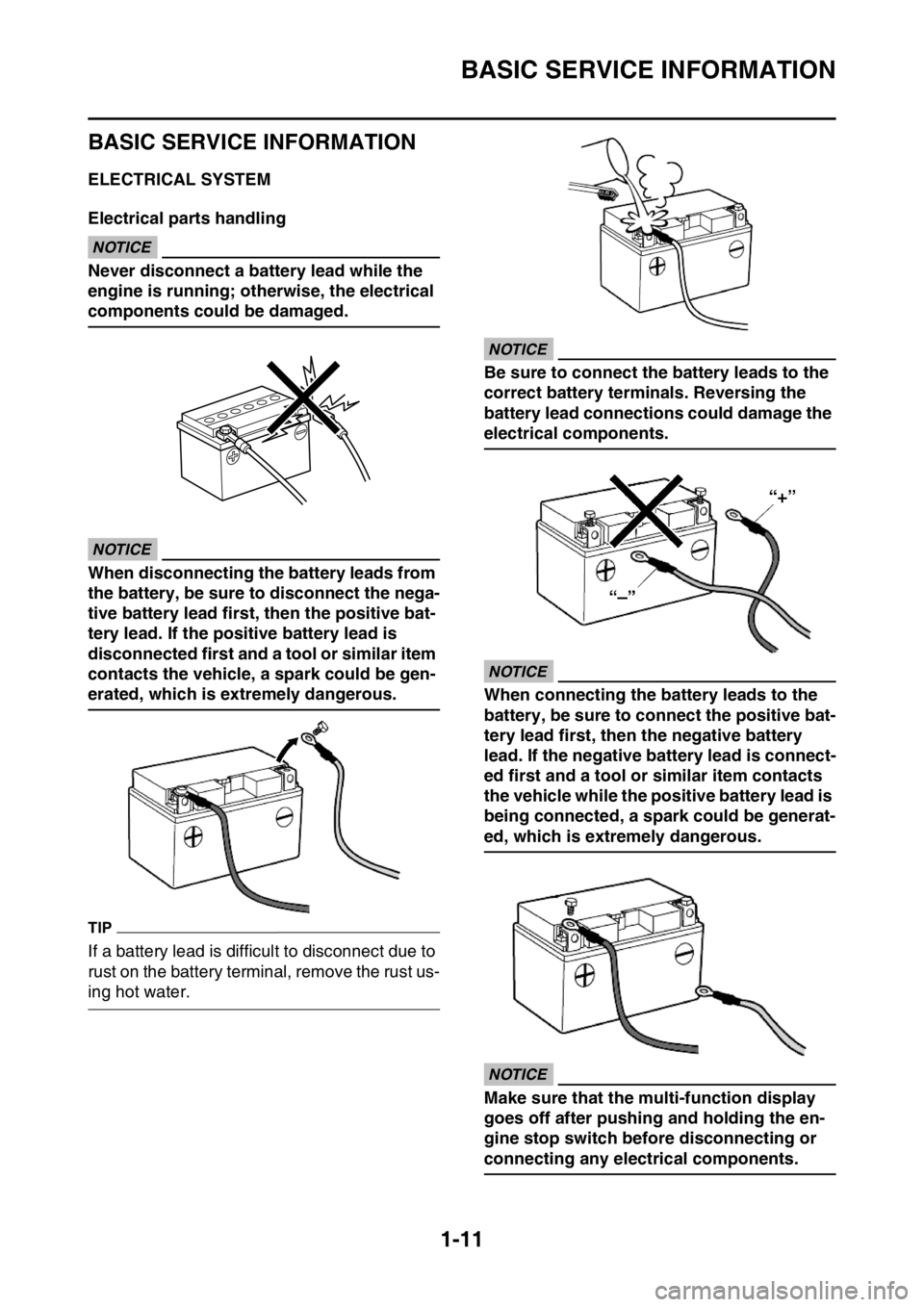
BASIC SERVICE INFORMATION
1-11
EAS2GB2028
BASIC SERVICE INFORMATION
EAS2GB2029ELECTRICAL SYSTEM
Electrical parts handling
ECA
NOTICE
Never disconnect a battery lead while the
engine is running; otherwise, the electrical
components could be damaged.
ECA
NOTICE
When disconnecting the battery leads from
the battery, be sure to disconnect the nega-
tive battery lead first, then the positive bat-
tery lead. If the positive battery lead is
disconnected first and a tool or similar item
contacts the vehicle, a spark could be gen-
erated, which is extremely dangerous.
TIP
If a battery lead is difficult to disconnect due to
rust on the battery terminal, remove the rust us-
ing hot water.
ECA
NOTICE
Be sure to connect the battery leads to the
correct battery terminals. Reversing the
battery lead connections could damage the
electrical components.
ECA
NOTICE
When connecting the battery leads to the
battery, be sure to connect the positive bat-
tery lead first, then the negative battery
lead. If the negative battery lead is connect-
ed first and a tool or similar item contacts
the vehicle while the positive battery lead is
being connected, a spark could be generat-
ed, which is extremely dangerous.
ECA
NOTICE
Make sure that the multi-function display
goes off after pushing and holding the en-
gine stop switch before disconnecting or
connecting any electrical components.
Page 26 of 430
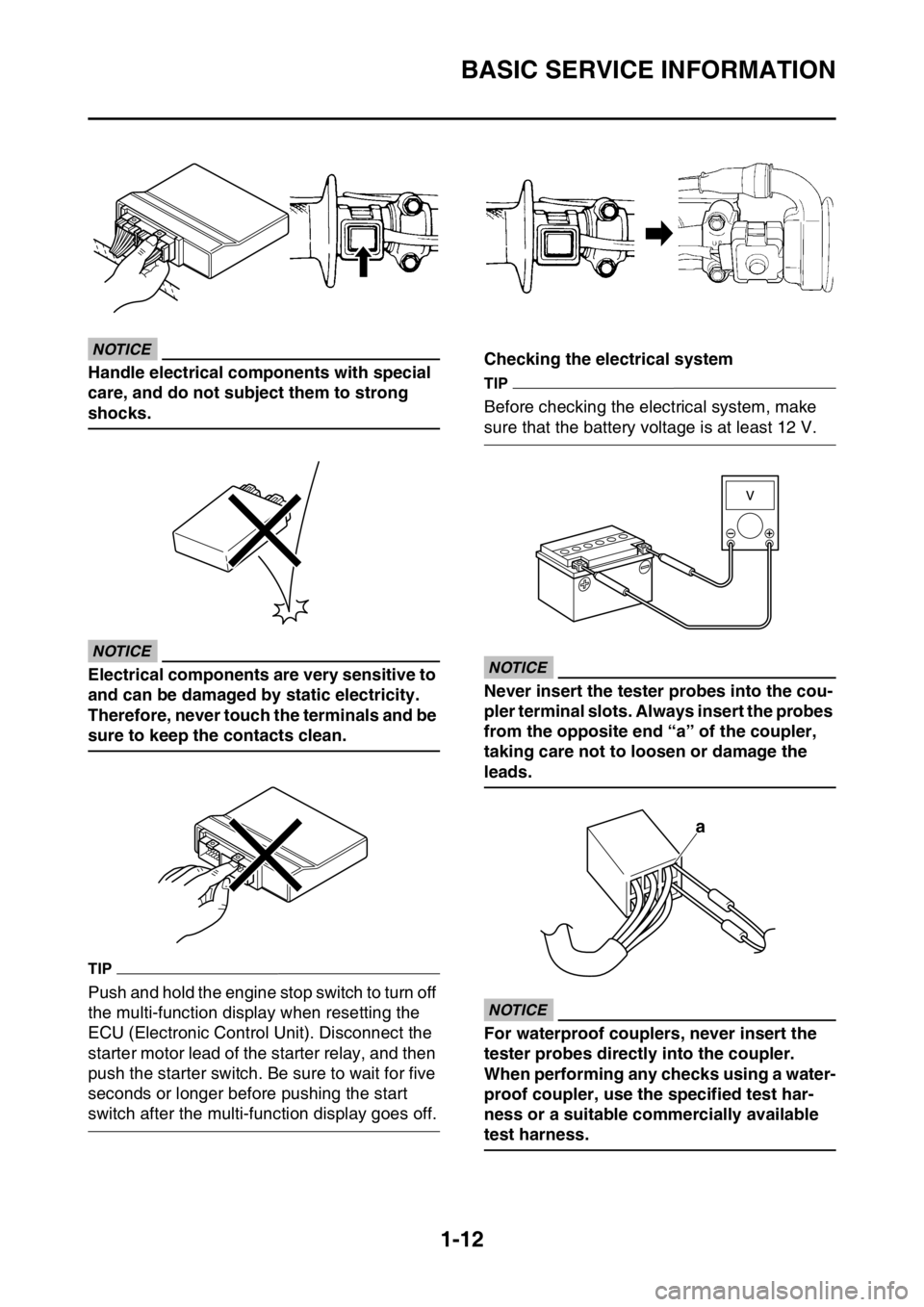
BASIC SERVICE INFORMATION
1-12
ECA
NOTICE
Handle electrical components with special
care, and do not subject them to strong
shocks.
ECA
NOTICE
Electrical components are very sensitive to
and can be damaged by static electricity.
Therefore, never touch the terminals and be
sure to keep the contacts clean.
TIP
Push and hold the engine stop switch to turn off
the multi-function display when resetting the
ECU (Electronic Control Unit). Disconnect the
starter motor lead of the starter relay, and then
push the starter switch. Be sure to wait for five
seconds or longer before pushing the start
switch after the multi-function display goes off.Checking the electrical system
TIP
Before checking the electrical system, make
sure that the battery voltage is at least 12 V.
ECA
NOTICE
Never insert the tester probes into the cou-
pler terminal slots. Always insert the probes
from the opposite end “a” of the coupler,
taking care not to loosen or damage the
leads.
ECA
NOTICE
For waterproof couplers, never insert the
tester probes directly into the coupler.
When performing any checks using a water-
proof coupler, use the specified test har-
ness or a suitable commercially available
test harness.
a
Page 27 of 430

BASIC SERVICE INFORMATION
1-13
Checking the connections
Check the leads, couplers, and connectors for
stains, rust, moisture, etc.
1. Disconnect:
• Lead
• Coupler
• Connector
ECA
NOTICE
• When disconnecting a coupler, release the
coupler lock, hold both sections of the
coupler, and then disconnect the coupler.
• There are many types of coupler locks;
therefore, be sure to check the type of cou-
pler lock before disconnecting the cou-
pler.
ECA
NOTICE
When disconnecting a connector, do not
pull the leads. Hold both sections of the
connector, and then disconnect the con-
nector.2. Check:
• Lead
• Coupler
• Connector
Moisture Dry with compressed air.
Rust/stains Connect and disconnect sev-
eral times.
3. Check:
• All connections
Loose connection Connect properly.
TIP
• If the pin “1” on the terminal is flattened, bend
it up.
• After disassembling or assembling a coupler,
pull on the leads to make sure that they are in-
stalled securely.
1
Page 28 of 430

BASIC SERVICE INFORMATION
1-14
4. Connect:
• Lead
• Coupler
• Connector
TIP
• When connecting a coupler or connector,
make sure that both terminals are connected
securely.
• Make sure all connections are tight.
5. Check:
• No continuity
TIP
• If there is no continuity, clean the terminals.
• When checking the wire harness, perform
steps (1) to (4).
• As a quick remedy, use a contact revitalizer
available at most part stores.Pocket tester
90890-03112
Analog pocket tester
YU-03112-C
Page 29 of 430

SPECIAL TOOLS
1-15
EAS2GB2030
SPECIAL TOOLS
The following special tools are required for accurate and complete adjustment and assembly. Using
the correct special tool will help prevent damage caused by the use of improper tools or improvised
techniques. The shape and tool number used for the special tool differ by country, so two types are
provided. Refer to the list provided to avoid errors when placing an order.
TIP
• For U.S.A. and Canada, use tool number starting with “YM-”, “YU-”, or “ACC-”.
• For others, use tool number starting with “90890-”.
Tool name/Part number How to use Illustration
Dial gauge & stand set
90890-01252
Dial gauge set
YU-03097-BThis tool is used to check
parts for runout or bend.
Crankshaft installer pot
90890-01274
Installing pot
YU-90058This tool is used to install the
crankshaft.
Crankshaft installer bolt
90890-01275
Bolt
YU-90060This tool is used to install the
crankshaft.
Adapter (M12)
90890-01278
Adapter #3
YU-90063This tool is used to install the
crankshaft.
Piston pin puller set
90890-01304
Piston pin puller
YU-01304This tool is used to remove
the piston pin.
Page 30 of 430
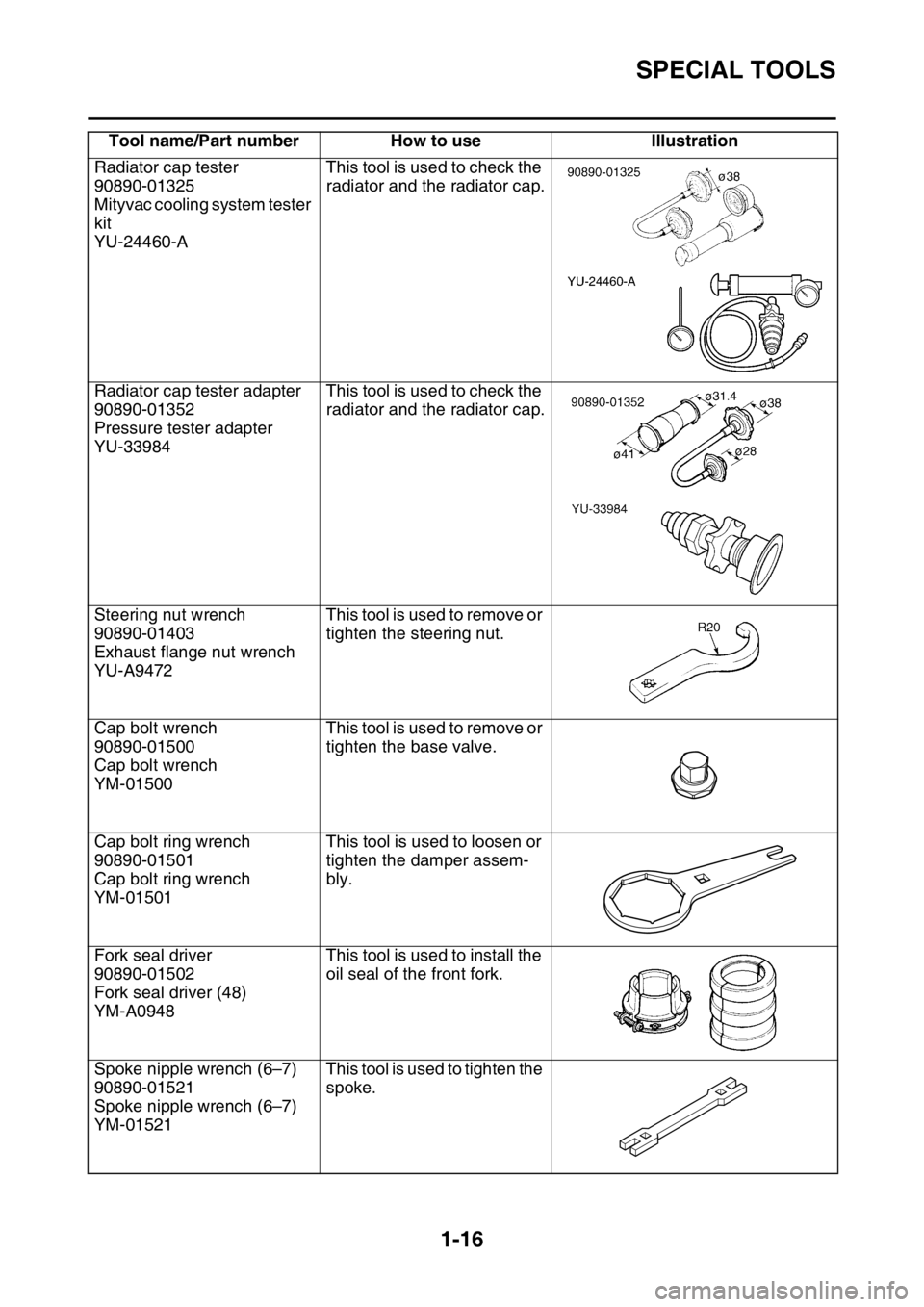
SPECIAL TOOLS
1-16
Radiator cap tester
90890-01325
Mityvac cooling system tester
kit
YU-24460-AThis tool is used to check the
radiator and the radiator cap.
Radiator cap tester adapter
90890-01352
Pressure tester adapter
YU-33984This tool is used to check the
radiator and the radiator cap.
Steering nut wrench
90890-01403
Exhaust flange nut wrench
YU-A9472This tool is used to remove or
tighten the steering nut.
Cap bolt wrench
90890-01500
Cap bolt wrench
YM-01500This tool is used to remove or
tighten the base valve.
Cap bolt ring wrench
90890-01501
Cap bolt ring wrench
YM-01501This tool is used to loosen or
tighten the damper assem-
bly.
Fork seal driver
90890-01502
Fork seal driver (48)
YM-A0948This tool is used to install the
oil seal of the front fork.
Spoke nipple wrench (6–7)
90890-01521
Spoke nipple wrench (6–7)
YM-01521This tool is used to tighten the
spoke. Tool name/Part number How to use Illustration